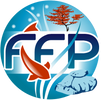Waterford Gardens 74 E. Allendale Rd. Saddle River NJ 07458908-266-6862


|
Koi Nutrition Regular observation of your fish will allow problems to be detected early. Be familiar with your fish's normal shape, size and color as well as swimming habits.
A change in these factors may signal a problem. The problem must be identified in order to know the steps to take for treatment. Every pond owner with fish, at some time or another, will probably have to medicate their pond.
Though Koi and Goldfish are extremely hardy, it is very important to keep a watch on their environment to keep them at their healthiest.
Attention should be paid to the quality of water and balance of the pond (i.e. pH levels etc.). However, if problems do occur, the first step is to remove the individual fish or decide whether to treat the entire pond.
It is sometimes difficult to be aware of a problem with a fish until its too late. Be aware of your fish's behavior patterns so changes can be detected early. A change in your fish's behavior is usually the first sign that that your fish are stressed or ill.
It is important that you know your pond's volume. All treatments are based on the number of gallons in the pond. The wrong dosage could result in killing your fish.
The type of food you give your Koi and the quantity you offer them will vary according to their size. The majority of proprietary Koi foods have a cereal base with different ingredients added either to enhance color or aid digestion.
Choose a food size that is small enough to be eaten by the smallest fish in the pond; otherwise they may die of starvation. If you keep very small Koi with larger ones, offer a mixture of large and small foodstuffs, but always make sure that young fish are adequately fed.
Most Koi food comes in two forms: floating and sinking. Koi are bottom-feeding fish and are, therefore, better suited to sinking food. This is made by compressing the meal through a die at high pressure. The meal is held together with fats and, again, takes a long time to be dissolved by cold water. The disadvantage with relying on this type of food is that you will be deprived of seeing your Koi feeding.
Fortunately, Koi will take food from the surface - indeed, you can even tame your Koi to feed from your hand - and special expanded (hollow) foods have been formulated for this purpose. These are steam cooked to create an outer shell, which protects the food particle from saturation for a while. (Once the pond water has dissolved the shell, the food will sink.) Another advantage with floating food is that it is easy to see when the Koi have eaten enough. Take care when feeding sinking types - uneaten food can easily pass unobserved, particularly in murky water.
Provide just enough food so that after five minutes it has all been eaten. On Koi farms in summer, smaller Koi (i.e. below 15-20 cm/6-8in in length) are fed five percent of their body weight per day, where-as large mature Koi (i.e. over 20cm/8in long) are only fed two percent. The nutritional value of Koi food is calculated by weight and not by volume. Normally, 1kg (2.21b) of fish food will increase Koi growth by 500gm or even 700gm in favorable conditions. In the winter, provide wheat germ based diets on a maintenance basis, in order to keep the body functions ticking over, since it is too cold for the Koi to grow. Wheat germ is also a good source of Vitamin E.
Feeding to enhance Koi color.
Koi are highly valued for their color and certain additives can be included in the diet to maintain and enhance the fish's natural coloration. Carotene affects the red pigmentation, but if used at too high a concentration, even the white pigment on the Koi will turn pink. Spirulina platensis also enhances and fixes the red pigment, but does not turn the white to pink to the same extent. It is a type of algae found and cultured in Mexico and eaten by the people, since it contains a high level of protein. Initially, it was fed to Koi on account of its nutritional value and not because of its color-enhancing characteristics. Now that these have been established, it is fed to Koi for only one month each year, usually during September, but can be given at any time, even during colder periods, at temperatures of 10c, but no lower. Some Koi farmers feed it for the month before the fish go to market to bring out the best colors in the Koi.
Good coloration is not only enhanced by good feeding, however. Healthy fish tend to have much brighter colors than diseased ones. To bring out the color in Koi, particularly the white, you must provide good living conditions. Strong red and yellow pigments develop well in waters rich in green phytoplankton (single-celled plants). Because Koi are difficult to see in green water, it helps to feed a diet that will enhance the red pigmentation. Black pigment is enriched in hard water with a pH level of 7.5-8.5. Remember, however, that changing the pH and hardness of the water can affect the toxicity of ammonia and nitrite.
|
